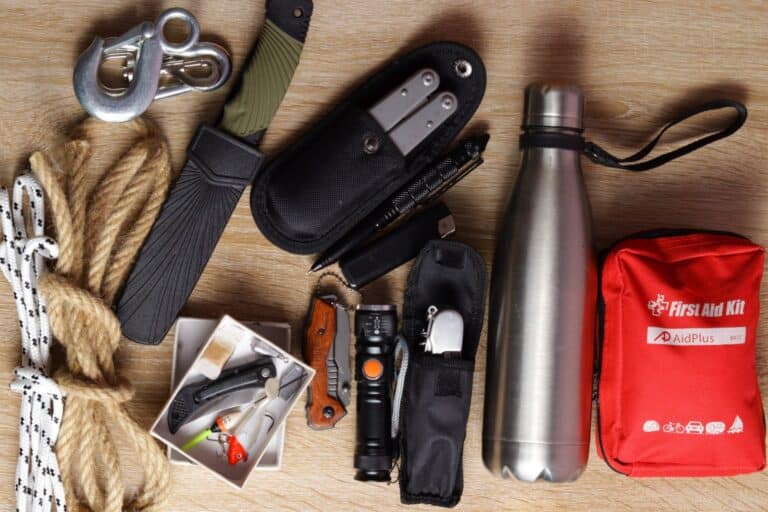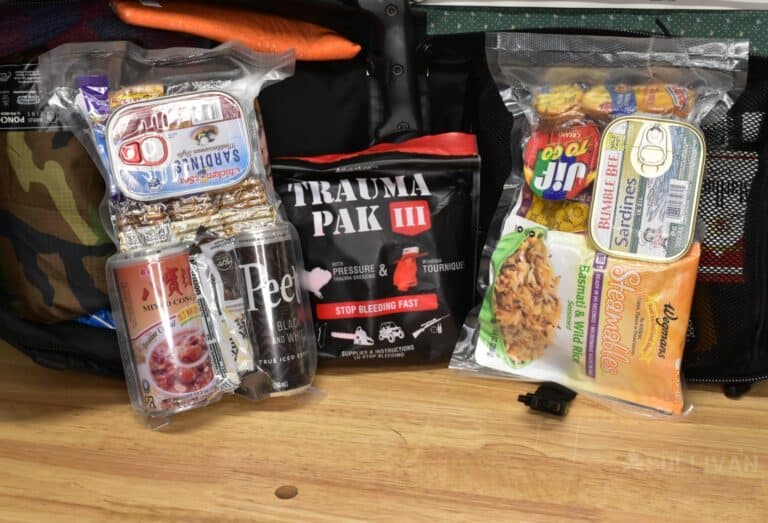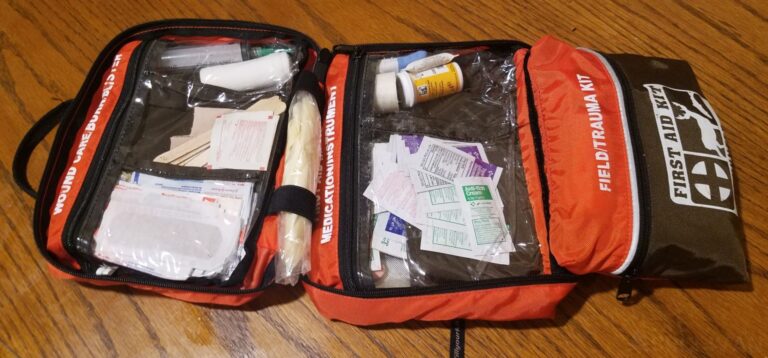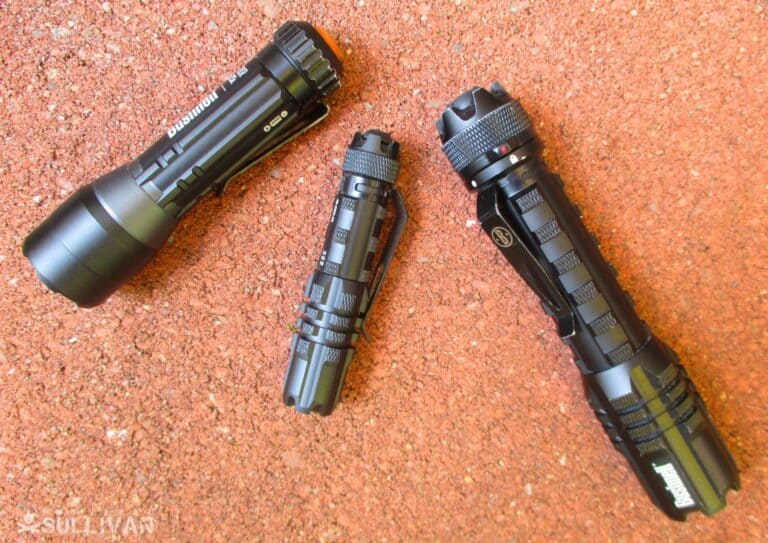If you live on the West Coast of the United States the possibility of an earthquake is very real. In the last 365 days there have been over 7,800 earthquakes in California alone. While the residents of California do not feel many of them, they happen daily.

In fact according to Uniform California Earthquake Rupture Forecast (UCERF3), there’s a 99.7% chance a 6.7M or greater earthquake will strike California within the next 30 years. The reality is that it’s not a matter of if but when the next big earthquake will hit the western coast of the United States.
This is not meant to scare but rather inform you. My goal is to make it possible for you to have a single-person go bag in case of an earthquake that will get you through the following 24 hours.
Buy a Kit, or Make Your Own?
While you can purchase pre-made kits, there is value in having your own DIY earthquake kit so you know the tools you are dealing with. Should you want to purchase a pre-built kit be aware of the claims made for food and water.
Many 72-hour kits claim to have 72 hours’ worth of water. This is dubious at best as these kits contain water pouches. Usually these pouches are about 4 ounces each, giving you 24 ounces of water total for a single person.
If you know the 8×8 rule or eight 8-ounce glasses of water a day rule then you know that this is the minimum amount of water a person needs per day. Eight 8-ounce glasses of water are almost two liters of water, while the 24 ounces in most 72 kits are less than a liter.
Along the same lines are 72-hour kit food bars which most people will not enjoy, especially children. I understand that sometimes there is an urge to take the path of least resistance however, in a survival or emergency situation comfort is helpful in keeping up morale as well as aiding in recovery and health.
If you packed foods you enjoy (i.e. peanut butter) and love instead of eating a lemon-flavored food ration you will increase your mental state and be more likely to survive hard times.
With those considerations in mind, let’s look at what you should include in your kit.
Water
- Water. Clean drinking water is going to be a precious commodity in the immediate aftermath of an earthquake. Unfortunately, water is extremely heavy and will weigh down your kit dramatically. Strive for about a liter of water per person to get you through the first day.
- Water Bottle. Just as important as the water itself is a sturdy water bottle that you can refill from other sources. Anything that is durable and leak proof will do the job here.
- Water Purification. One of the most commonly neglected items in survival kits is a method of water purification. Any earthquake that has you reaching for this kit is in all likelihood going to contaminate every convenient source of water, so you’ll need a way to purify it before you drink it unless you want to get hideously sick. You can use an emergency water filter or sterilization chemicals.
- Bleach. Household chlorine bleach is worth including in your earthquake survival kit since it can be used both for sterilization and the purification of water. Adding 7 or 8 drops to a gallon of water is all it takes to destroy any lurking, harmful microorganisms. Make sure you only use plain, regular sodium hypochlorite bleach with no additives or fragrances.

Food
- Ready-to-eat canned meats, fruits and vegetables. SPAM, Tuna, etc. Is high in calories and fat plus adds sodium to your diet. You can add jerky and pemmican to this list as they will give you the fuel you need as well.
- Protein or fruit bars. Granola and “Energy” bars are great walking food.
- Nuts, unless you have a nut allergy. Nuts are one of the best foods for hunger. Try to avoid salted nuts if you have salted meat/fish in your bucket as too much salt can be bad as well and will make you thirsty.
- Infant formula, if you have an infant with you; infants obviously have very particular nutritional requirements and so you need to have some infant formula in your kit.
- Soups, a quick, convenient, and filling meal
- Plastic Utensils. A basic selection of plastic cutlery is a smart inclusion in your kit. Multipacks of forks, spoons and knives are entirely adequate, or you can just go with sporks.
- Plates. You also want to have disposable plates to eat off of. This reduces the chances of incidental contamination when you were forced to eat on the go or in less than ideal conditions.
- Paper Cups. Just like having plates, you’ll want some disposable cups. You won’t always be chugging out of water bottles or canned drinks, and having something to mix up a powdered beverage in will be helpful.
- Manual can opener. More and more canned food these days has an easy open tab on the lid, but not nearly all. Make sure you have a manual can opener in your kit.
See more lightweight food suggestions here.
Important Family Documents
You should always have important documents with you.
- ID
- Passport
- Property Deeds
- Birth certificate
- Marriage certificates
First Aid Kit
After an earthquake, you, a family member, or friend may be cut, burned or suffered other injuries. If you have these basic supplies you are better prepared to help yourself and others when they are hurt. Knowing how to treat minor injuries can make a difference in an emergency.
Consider taking a first aid class, but simply having the following things can help you stop bleeding, prevent infection and assist in managing further health issues. If possible purchased a sealed first aid kit.

The First Aid Kit should include the following:
- Gauze. Gauze is always a go-to staple in a first-aid kit. You’ll use it for bandaging, packing penetrating injuries and dressing lacerations. Make sure you have plenty, both in roll and pad form. Consider adding hemostatic gauze for more serious injuries or wounds to the head and neck.
- Soap and/or antibiotic wipes.
- Antibiotic ointment.
- Adhesive bandages in a variety of sizes.
- Thermometer.
- Non-prescription drugs (aspirin or non-aspirin pain reliever, anti-diarrhea medication, antacid, laxatives)
- Tweezers
- Feminine Supplies
- Disinfectant
- Scissors
- and more
Pet Supplies
Don’t forget about your furry, feathered or scaly friends in the aftermath of an earthquake. Make sure you have any and all required supplies and equipment for their transportation and care, within reason.
- Pet food. You want a quantity of long-lasting, shelf stable pet food as part of your earthquake survival kit. Make sure you carefully investigate the longevity of the food you include in your kit, because it might not have a reliable expiration date on the package.
- Collapsible water bowl. Include a collapsible water bowl or dribbler as appropriate for the species of your pet. You can fill this from your supply of water or from water that you have treated that you recover in the aftermath.
- Pet meds. If your pet requires any ongoing treatment with medication or supplements in the form of minerals and vitamins, make sure you have those on hand too.
- Leash. Controlling and corralling your pet is going to make the situation even more difficult, particularly if they are injured or just stressed out of their mind. Don’t count on being able to locate their leash when you need it, have a spare in your kit.
- Harness/Collar. This goes with the leash to help you control your pet. A spare collar is a great idea for dogs and cats, but you might want to consider including a harness as well even if they don’t usually wear one. Having a convenient way to grab and lift your pet could be important.
Other Items
Many times we have the basics in our kits but forget things that can make life easier and safer. Sanitation may be down for a bit so making sure you can stay clean goes a long way.
The risk for waterborne and other diseases increases after a disaster as access to water, exposure, and even contact with dead bodies (human and animal) are much more likely.
Keeping yourself clean, your shelter picked up and your waste separate and contained will lower your chances of turning a simple cut into a full-on infection.
With the advancement of cell phones having a way to power and charge your phone to call for help or reach out to loved ones is a great jump forward.
Many people let their phone die and have no way to recharge. When developing this list, communication was a big part of what I wanted to integrate into the bucket.
Also consider:
- a warm blanket or a few emergency blankets
- Pen and pencil for taking or leaving notes
Personal Hygiene Items
- Toothbrushes. Self-explanatory. You might be able to go a day or two without brushing your teeth in an emergency, but you definitely don’t want to put it off longer than you have to.
- Toothpaste. You’ll need this to do a good job of brushing your teeth.
- Moist towelettes. Water, particularly clean water, is going to be at a premium in the aftermath of an earthquake. You still need to wash your body, however, to keep odor at bay and reduce the risk of infection. A large pack of moist towelettes will do the job well enough.
- Feminine Supplies. If required for yourself or others in your family, make sure you have tampons, pads and other such items.
- Hand Sanitizer. Keeping your hands clean and free of germs is going to be a full-time job when picking up the pieces after an earthquake but as mentioned several times water is going to be a precious commodity. Strong, alcohol-based hand sanitizer will do a fine job of keeping your hands germ-free and preventing easy transmission.
- Garbage bags and plastic ties. Chances are very good that sewer systems and toilets are going to be completely out of commission after a powerful earthquake. The call of nature, however, will continue as it always has. You can use heavy duty garbage bags and plastic ties in conjunction with an improvised toilet for the secure storage of human waste. You don’t want to risk human waste contaminating the environment in such a situation.
Baby Care Items
If you or anyone else in your family is caring for a baby, it is imperative you have at least a small supply of baby care items in your emergency kit.
- Diapers. Self-explanatory. Disposable diapers will ease hygiene concerns somewhat.
- Infant formula. Babies have substantial nutritional requirements that must not be interrupted. Even if the baby is normally breastfed by Mom you might not be able to count on that under the circumstances. Formula that is ready to mix will give you a backup option for feeding time.
- Ointments/powders. Keeping baby clean, dry and happy will help reduce the stress level in what is already going to be an enormously stressful event. The usual battery of powders and ointments for treating irritation is a smart inclusion.
- Clothes. A clean change of clothes for baby is another smart inclusion.
Personal Protective Equipment
- Goggles. Airborne debris, dust, fumes and other hazards will be abundant after the quake and hell on your eyes. A good set of goggles will help protect your eyes until you are clear of danger
- Respirator. Those same airborne hazards will also do quite a number on your lungs, particularly if you live in the middle of a built up area that is likely to be ravaged by the quake. A respirator with high efficiency filter cartridges will allow you to breathe normally, for a time, until you can get away from the worst of the damage.
- Dust Masks. As an alternate or backup option to the respirator, high efficiency dust masks that fit snugly will provide a measure of protection against airborne dust and some fumes.
- Gloves. Protecting your hands will be paramount. Broken glass, twisted metal and countless other hazards will wait to cut you open. Protect your hands with a good pair of work gloves, your choice.
Communications
- Cell phone charger. Have a backup set of cords and outlet adapters for your cell phone in your emergency preparedness kit. It is highly likely that you won’t have access to any working outlet beyond what a vehicle can provide, but once you get to safety you’ll need them.
- Power bank. A fully charged power bank can extend your uptime while evacuating from an earthquake ravaged area.
- Solar charging system. The worst earthquakes might devastate a large geographic area, meaning that it is conceivable you won’t find access to electricity or charging your devices at all. A lightweight, portable solar charging system can allow you to keep your devices fueled using nothing more than the sun.
- Emergency radio. A crank operated emergency radio can allow you to stay up to date on the situation and relief efforts even when all other communication methods fail.

Tools
- Flashlight/headlamp. Considering most light sources will be destroyed or lack power after an earthquake, you’ll need to bring your own. Flashlights and headlamps will allow you to navigate or work during conditions of low light.
- Extra batteries. If your flashlights aren’t rechargeable and you don’t have a solar charger, see above, you’ll need spare batteries to keep them lit up. Make sure you rotate your batteries periodically as they will self-discharge in storage.
- Signal Whistle. The sharp blast of a survival whistle can allow you to gain attention from rescuers or other people in your group even across a great distance and over the din of evacuation efforts.
- Multitool. You will not have the space or weight allowance for a comprehensive toolkit, but a good multi-tool is capable of taking care of most tasks. Choose the now typical multi-plier arrangement or a classic Swiss Army knife.
- Duct tape. Duct tape is so useful for repairs and field improvisations this is a mandatory inclusion in your kit. You can crush down the roll of tape to save room, or unwind it and wrap it around another object in the kit to save even more room.
- Strike-anywhere matches. The ability to start a fire might make the difference between staying warm or freezing at night, or in a cold climate. Matches are reliable and easy to use.
- Notepad and pen. When you need to write down critical information quickly, nothing beats the simplicity of a notepad and pen. I would recommend a weatherproof version of both for your earthquake kit.
- Wrench.
- Pliers.
Personal Docs Package
- Personal Docs. Assuming you have survived the earthquake, life will eventually get back to normal, but first you’re going to have to interact with a lot of bureaucracies and agencies to prove that you are who you say you are and own what you say you own. Store copies of your ID and important family records in a waterproof container and, if possible, on a USB drive – birth certs, marriage certs, SS cards, homeowner/renters/earthquake insurance, etc.
- Cash. You should not count on any other form of payment being acceptable in the aftermath of an earthquake. Cash will still get things done and get you supplies you desperately need.
Wrap-Up
If you live on the west coast or near a fault line you should be prepared for an earthquake. Taking steps to be prepared for the loss of your home and belongings should be taken into account as earthquake insurance can be purchased separately from your normal homeowners’ or renters’ insurance.
Taking this extra step to cover your belongings is often overlooked until it is too late.
Notice that there are no clothing requirements for your emergency bucket. This can be added but I have found that usually, the bucket cannot hold all these items plus extra shoes, socks, underwear, shirts, and pants. The point of the bucket is to be a quick grab and go single-purpose item.
While I generally endorse an earhquake stockpile, this survival/emergency kit can be a first step towards a great 72-hour kit, or it can be in addition to one you may already have. Planning for future events and emergencies should be a part of your family’s monthly priorities.

James C. spent four years as a Gunner’s Mate in the United States Navy. He served two tours to the Persian Gulf and played a role in the Operation Iraqi Freedom.
He has a Master’s Degree in Military History as well as an MBA. After leaving the Navy he married his wife, Krystal in Las Vegas and later joined the church in 2005. He and his wife have two daughters, Hannah and Emma.
